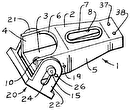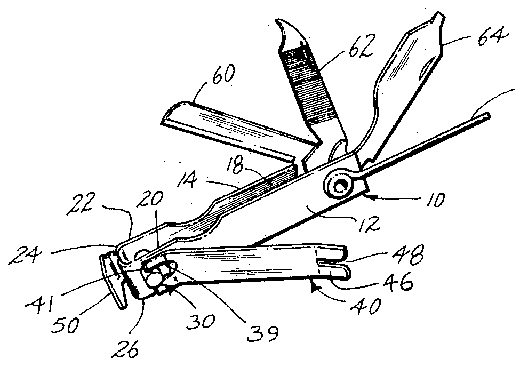
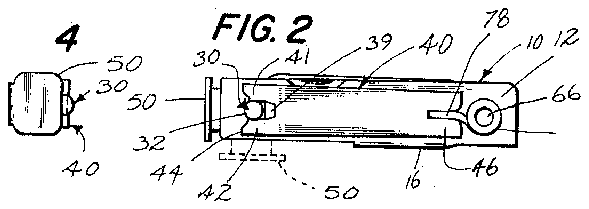
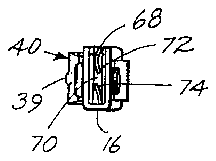
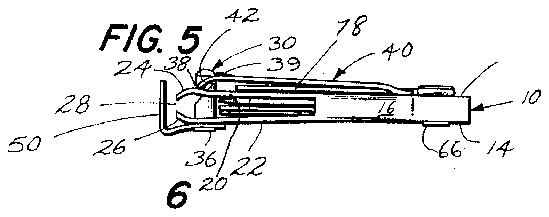
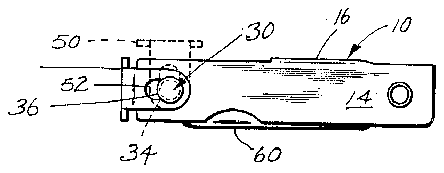
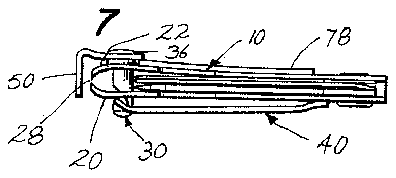
- 2x
- 6blades
- 10casing
- 12top wall portion
- 14bottom wall portion
- 18pocket
- 22unconnected lengths
- 24jaw elements
- 26jaw elements
- 28suitable aperture or slot
- 30post
- 36head
- 38undercut notch
- 39aperture
- 40lever
- 41transverse end strap
- 42mounting end portion
- 46free end portion
- 48slot
- 50tamping member
- 52elongated aperture
- 60adjacent blade members
- 66rivet
- 68shank
- 70radial slot
- 72angular sections
- 74angular sections
- 78reamer
- 143s patents 864,703 3/1907 sibley 30-155 x
- 1793276.4 x 2,477,782 8/1949 bassett 3028 x
- 180lever 40 pivoted
- 189baer 30143 3,089,239 5/1963 loda 30-28 x
- 424united states patents
- 477155 x 1,143,761 6/1915 hammond 13276.4 x
- 651united states patents
- 703examiner united states patents
- 7243276.4 x 2,477,782 8/1949 bassett 3028 x
- 761s patents 864,703 3/1907 sibley 30-155 x
- 782155 x 1,143,761 6/1915 hammond 13276.4 x
- 864examiner united states patents
- 996baer 30143 3,089,239 5/1963 loda 30-28 x
Description
y 2, 1967 H. N. BLISS 3,316,634
COMBINATION IMPLEMENT AS SEMBLY Filed Oct. 22, 1965 INVENTOR. HARVEY N. BLISS United States Patent Gfifice IMPLEMENT ASSEMBLY Windsor, Conn, assignor to The Britten Newington, Conn, a corporation of Con- The present invention relates to a combination implement assembly, and more particularly to a combination implement assembly providing a nail clipper and a plurality of :blade-like implements.
Many pocket knives provide a plurality of blade-like implements including a knife, nail file, screwdriver, a bottle opener, and like members as individual blade members or in the form of combination blade members capable of several functions. Folded sheet metal casings having widely employed here to reduce costs and ease of fabrication as a receptacle for such blade-like elements. Generally, nail clippers have been separate implements although some efforts have been made to combine knife units and nail clipper units as seen in United States Patents 1,424,651 andf2,724,179.
It is an object of the present invention to provide a novel combination nail clipper and blade-like implement assembly which is relatively compact, highly attractive, and relatively inexpensive to manufacture.
Another object is to provide such an assembly which also provides tools for use with tobacco pipes.
Still another object is to provide such an assembly which provides protection for the user from injury by the nail clipper jaws.
Other objects and advantages will be readily apparent from the following detailed specification and attached drawing wherein:
FIGURE 1 is a perspective view of the combination implement assembly of the present invention with various of the blade-like elements pivoted outwardly of the casing and with the operating lever and pipe reamer pivoted into operative position;
FIGURE 2 is a plan view of the implement assembly of FIGURE 1 with the blade-like elements and operative lever in closed position and with the tamping member illustrated in phantom line as rotated to one side of the assembly;
FIGURE 3 is a rear end elevational view thereof;
FIGURE 4 is a front end elevational view thereof;
FIGURE 5 is a side elevational view thereof;
FIGURE 6 is a bottom view thereof with the tamping member positioned to abut against the jaw elements and illustrated in phantom line rotated to one side of the assembly in inoperative position; and
FIGURE 7 is a side elevational view of another embodiment of this invention similar to that shown in FIGURES 1-6 except in the pivotal mounting of the reamer.
It has now been found that the foregoing and related objects and advantages may be readily attained in a combination implement assembly having a casing integrally formed of resiliently deflectable sheet material with a pair of spaced apart, generally elongated side wall portions and a base portion connecting the side wall portions from adjacent one end thereof but terminating inwardly from the other end thereof to provide unconnected lengths of the side wall. portions adjacent the other end which are resiliently deflectable relative to each other. The unconnected lengths are configured to provide cooperating nail clipper jaw elements at the free ends thereof and are biased apart in operative position to provide yieldable spacing between the clipper jaw elements. A post is provided intermediate the length of the unconnected lengths and has an elongated operating lever pivotably 3,316,634 Patented May 2, 1967 mounted thereon which extends generally longitudinaly of the side wall portions and is pivotable into operative position with its free end spaced above the side wall portions for biasing the unconnected lengths into engagement by the abutting of the clipper jaw elements. A pivot member is provided adjacent the connected side wall end of the casing and has at least one blade member pivotably mounted thereon which is receivable in the casing for rotation from a closed position disposed within the casing to an open position generally aligned with the elongated axis of the casing.
Thus, in the present invention, the casing is integrally formed of resiliently deflectable sheet metal and provides a pair of spaced apart side wall portions which provide both unconnected lengths thereof with nail clipper jaw elements on end thereof and a housing for blade-like implements pivotably supported at the other end thereof.
To protect the user from inadvertent contact with the clipper jaw elements and desirably to provide an additional tool for use by pipe smokers, a jaw protecting element is pivotably mounted on the post and has a portion extendin outwardly of the jaw elements in the operative position. This outwardly projecting portion is desirably planar and overlies substantially the entire end of the casing so that it provides maximum protection and may also be used for tamping tobacco in the'bowl of a smoking pipe. Although this element may have a gene-rally T- shaped portion with the leg portion of the T providing the pivotal mounting portion and extending between the clipper jaw elements, a generally L-shaped member is readily and economically fabricated from sheet metal with one leg being pivotably mounted on the exterior of the side walls of the casing and the other leg providing the outwardly projecting portion overlying the jaw elements. The pivotably mounted portion of the jaw protecting element has an elongated aperture permitting some sliding movement thereof outwardly from the end of the casing to permit pivoting thereof about the end of the casing.
To enhance further the versatility of the combination implement assembly of the present invention, an elongated pipe reaming element is desirably provided and may be mounted on the exterior of the casing on either the post or the pivot. By pivotably mounting the pipe reaming element on the pivot pin in a position underlying the operating lever, the free end of the lever may be notched to engage the pipe reaming element in the notch to prevent inadvertent relative pivoting therebetween. Alternatively, other interengagin-g means may be provided to limit inadvertent pivoting of the operating lever, and the pipe reaming element may be mounted on the post on the side wall portion opposite that which the operating lever overlies and have its free end engage in a notch or other recess in the casing or in an external portion of the pivot pin.
In the preferred embodiments, the lever is apertured adjacent one end and is pivotably engaged in an upwardly extending undercut notch on the post by the configuration of the aperture and the biasing pressure of the unconnected lengths and is configured adjacent its pivoted end in accordance with conventional construction to press the top unconnected length toward engagement with the bottom unconnected length when it is pivoted into operative position from an inoperative position closely overlying the upper side wall portion. On the other end of the casing, a rivet disposed in apertures in the side wall portions provides a pivot member upon which may be mounted a plurality of blade-like implements which are rotatable outwardly from the casing.
Although various means may be provided for resiliently retaining the blade-like elements in operative or housed position such'as separate springs, tight casings, or camtype pivot pins, the preferred embodiment of the present invention includes a plurality of blade-like members wherein the two blade members adjacent the side wall portions may have fiat shanks. In accordance with my copending application Ser. No. 402,409, one or more additional blades may be positioned between the outside blades and each of such inner blades may include a shank having an angular section which is deformed out of the pivotal plane defined when the blade is opened. This deformation may take the form of a dished angular shank section or the shank may have its angular portion split into two sections which are bent in opposite directions generally away from the pivotal plane of the blade. In either form, the desired degree of resiliently sliding, frictional engagement of the shank of the inner blade with its adjacent member is provided to assure that the blade members do not inadvertently fall open and also that when open, it is retained in that pOsitiOn.
This shank configuration provides a leaf spring portion which biases the shanks of the blades in sliding frictional engagement with the shanks of other blades and the side wall portions of the casing so that the blade, when opened, will be restrained in its opened position. Thus, the casing having side wall portions of resilient material together with the angular section of blade with the deformed portion provides surfaces which bear in sliding frictional engagement upon the shanks of the blades adjacent thereto when a blade is being opened and also to retain the blade in its open position when so desired.
Referring now in detail to the attached drawing, FIG- URES 16 illustrate an embodiment of the present invention which includes a casing integrally formed of resiliently deflectable sheet metal such as steel and is generally designated by the numeral 10. The casing has a top wall portion 12 and a spaced apart bottom wall portion 14 which are connected by a base portion 16 extending from one end toward the other end thereof to over substantially half the length of the casing 10 so that the casing 10 defines an elongated pocket 18. The side wall portions 12 and 14 are generally parallel, and the unconnected lengths or free end portions 20 and 22 are resiliently defiectable. The unconnected lengths 20 and 22 are configured to provide transverse cooperating clipper jaw elements 24 and 26 at the free ends thereof which are spaced apart in the operative position so as to provide a suitable aperture or slot 28 therebetween for the insertion of a finger nail or the like to be cut or trimmed by the combination implement assembly.
A post or pivot pin generally designated by the numeral 30 is rotatably seated in apertures 32, 34 in the top wall portion 12 and the bottom wall portion 14 and at one end has an enlarged head portion 36 which is larger than the aperture 34 in the bottom wall portion 14 to prevent the post 30 from passing axially therethrough toward the top wall portion 12. The opposite end portion of the post 30 extends through the aperture 32 and has an upwardly extending undercut notch 38 in the side thereof.
Pivotably mountedon the post 30 is the elongated operating lever generally designated by the numeral 40 which is formed with a mounting end portion 42 inclined downwardly with respect to the body of the lever 40, and the mounting end portion 42 has an aperture 39 therein defining the transverse end strap 41. The transverse end strap 41 engages in the notch 38 with the biasing pressure of the unconnected lengths 20 and 22 maintaining the strap 41 against the upper surface of the undercut notch 38 to hold the lever in assembly upon the post 30.
In accordance with conventional practice, when it is desired to utilize the nail clipper portion of the casing 12, the lever 40 and post 30 are rotated and the lever 40 pivoted 180 about the post 30 so that the mounting end portion 42 abuts against the surface of the unconnected length 20 with the free end portion 46 thereof projecting upwardly therefrom as illustrated in FIGURE 1. By depressing the free end portion 46 toward the top wall portion 12, the mounting end portion 42 applies downward pressure to the unconnected length 20 and causes deflection until the jaw elements 24, 26 come into engagement.
Pivotably mounted on the post 30 between the head 36 and the bottom wall portion 14 is an L-shaped jaw protecting and tamping member 50 which has an elongated aperture 52 therein of smaller width than the head 36. In this manner, the tamping member 50 is slidable relative to the post 30 in the elongated aperture 52 and is rotatable from a position outwardly of the jaws 24, 26 to an unobstructing position to the side of the casing 10 as shown in phantom line in FIGURE 2. When the protecting member 50 is in the jaw protecting position, it may be used as an implement for pressing or tamping tobacco in the bowl of a pipe or for other uses while, at the same time protecting and covering the jaw elements 24 and 26. However, it may be readily rotated from the tamping position to the side position so that the combination implement assembly may be used as a nail clipper.
On the other or unconnected end of the casing, three blade members 60, 62, and 64 are received in the pocket 18 between side wall portions 12 and 14 and are pivotably mounted on the rivet 66 adjacent the end. In order to provide frictional resilient bearing force upon the blade members 60, 62, and 64, the intermediate blade member 62 includes spring means to insure that the blades of the assembly are properly held in either open or closed position with desirable resistance to opening or closing movement of a blade simulating the action of conventional springloaded pocket knives. The utility portion of the blades 60, 6 2, and 64 may take only one or a number of forms such as a nail file, a knife blade, a screwdriver, a bottle opener, or like elements or combinations thereof.
The shank of the intermediate blade member 62 divided by a radial slot 70 extending to the pivot aperture (not shown) to provide angular sections 72 and 74 which are bent in opposite directions normal to the pivotal plane of the blade to provide a compressible spring biasing the shank portions of the other blades 60 and 64 against the side wall portions 12, 14.
In this manner, the deformed or bent angular sections 72 and 74 take a generally arcuate configuration so that the shank 68 resiliently bears upon the shanks of adjacent blade members 60 and 64 in the closed position and upon movement of the blade member to the open position. The shank sections 72 and 74 will bear in sliding frictional engagement against the adjacent blade members 60 and 64 to provide sliding frictional engagement effective during opening and closing of the blades in a smooth manner without damage or undue wear to the shank portions of blades 60 and 64.
Pivotably mounted on the rivet 66 on the exterior surface of the side wall portion 12 is a reamer 78 formed of wirelike material which may be pivoted into an operative position as shown in FIGURE 1 for cleaning the bowl of a pipe. The reamer 78, when in the inoperative position shown in FIGURE 2, is engaged within the slot 48 in the free end portion 46 of the operating lever 40 to lock the two elements together against inadvertent relative pivotal movement.
Referring now to FIGURE 7, the embodiment therein shown is essentially the same as that of FIGURES 1-6 but the reamer 78 is pivotably mounted on the post 30 on the exterior surface of the bottom wall portion 14. Here the free end of the reamer 78 may lock in a notch (not shown) in the head of the rivet 66 and the free end of the operating lever 40 may be engaged with a stud (not shown) on the side wall 12 of the casing 10', thus restraining both pivotal members against inadvertent movement.
Thus, it can be seen that the present invention provides a novel combination implement assembly which is relatively compact, highly atractive and relatively inexpensive to manufacture. The casing is integrally formed from a single sheet of resiliently defiectable sheet metal to provide both a nail clipper portion and a cover portion for housing a plurality of blade-like implements. In addition, the pivotable jaw protecting element not only acts as a protector but also as a pipe tamper and a reaming tool is also advantageously included. In this manner, the present invention provides a highly versatile combination implement which is relatively easily assembled from parts which are readily and economically fabricated.
Having thus described the invention, I claim:
1. A combination implement assembly comprising: a casing integrally formed of resiliently deflectable sheet metal having a pair of spaced apart, generally elongated side wall portions and a base portion connecting said side wall portions from adjacent one end thereof but terminating inwardly from the other end thereof to provide unconnected portions of said side wall portions adjacent said other end resiliently defiectable relative to each other, said unconnected portions providing cooperating nail clipper jaw elements, and said unconnected portions being biased apart in operative position to provide yieldable spacing between said clipper jaw elements; a post intermediate the length of said unconnected portions; an elongated operating lever pivotably mounted on said post and extending generally longitudinally of said side wall portions for biasing said unconnected portions into engagement by the abutting of said jaw elements; a pivot member adjacent said one end thereof; at least one blade member receivable in said casing and mounted on said pivot member for rotation from a closed position disposed in said casing to an open position generally aligned with the elongated axis of said casing; and a jaw protector pivoted on said post and having a portion thereof extending outwardly of said jaw elements to protect said jaw elements from inadvertent contact, said jaw protector being pivotable to one side of said jaw elements whereby said implement assembly may be used as a nail clipper.
2. A combination implement assembly comprising: a casing integrally formed of resiliently defiectable sheet metal having a pair of spaced apart, generally elongated side wall portions and a base portion connecting said side wall portions from adjacent one end thereof but terminating inwardly from the other end thereof to provide unconnected portions of said side wall portions adjacent said other end resiliently defiectable relative to each other, said unconnected portions providing cooperating nail clipper jaw elements, and said unconnected portions being biased apart in operative position to provide yieldable spacing between said clipper jaw elements; a post intermediate the length of said unconnected portions; an elongated op. erating lever pivotably mounted on said post and extending generally longitudinally of said side wall portions for biasing said unconnected portions into engagement by the abutting of said jaw elements; a pivot member adjacent said one end thereof; at least one blade member receivable in said casing and mounted on said pivot member for rotation from a closed position disposed in said casing to an open position generally aligned with the elongated axis of said casing; a jaw protector pivoted on said post and having a portion thereof extending outwardly of said jaw elements to protect said jaw elements from inadvertent contact, said jaw protector being pivotable to one side of said jaw elements whereby said implement assembly may be used as a nail clipper; and an elongated reamer pivotably mounted on the exterior of said casing for rotation in a plane generally parallel to the plane of rotation of said blade member wherein said lever has an interengaging portion engageable with said reamer for positioning said lever in an inoperative position on said casing.
References Cited by the Examiner UNITED STATES PATENTS 864,703 3/1907 Sibley 30-155 X 1,143,761 6/1915 Hammopan>pan>nd 13276.4 X 2,477,782 8/1949 Basn>n>n>sett 3028 X 2,724,179 11/1955 Baer span>span>span>30143 3,089,239 5/1963 Loda 30-28 X 3,189,996 6/196-5 Casey 30-28 WILLIAM FELDMAN, Primary Examiner. G. WEIDENFELD, Assistant Examiner.









